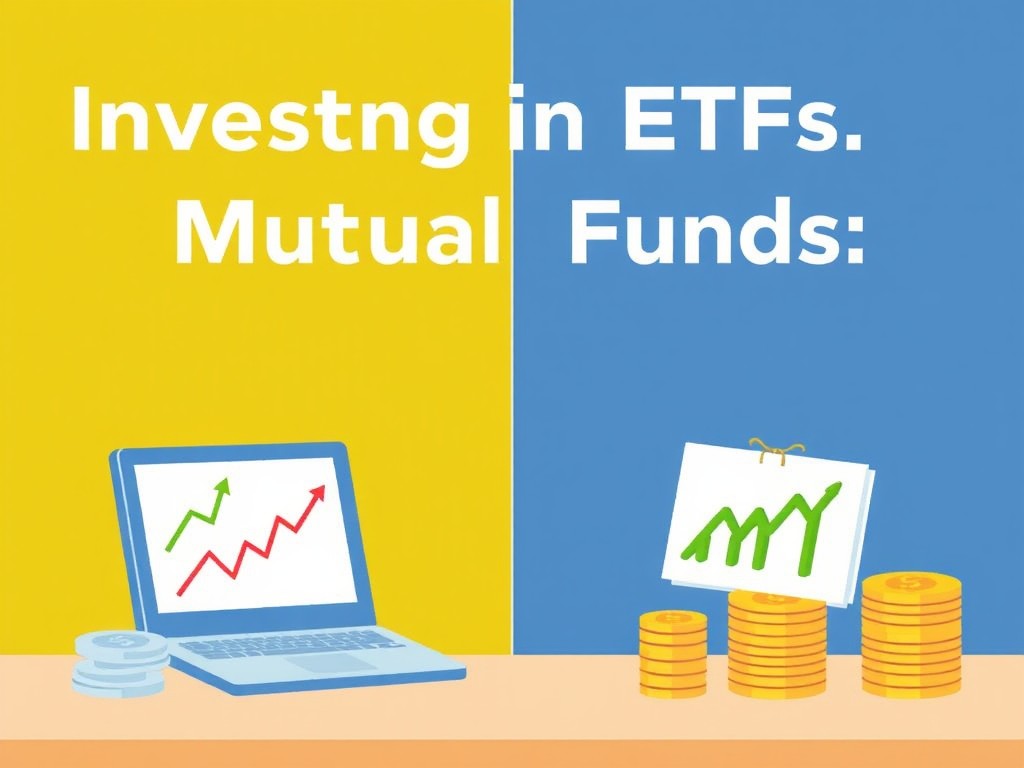Comparing Costs: ETFs vs. Mutual Funds
When considering investment options, understanding the cost implications of exchange-traded funds (ETFs) and mutual funds is crucial for making informed decisions. Both investment vehicles offer unique advantages, but their cost structures can significantly impact an investor’s overall returns. Therefore, a thorough comparison of these costs is essential for determining which option might be more suitable for individual financial goals.
To begin with, ETFs are often lauded for their cost-effectiveness, primarily due to their passive management style. Most ETFs aim to replicate the performance of a specific index, which typically results in lower management fees compared to actively managed mutual funds. These management fees, known as expense ratios, are a critical factor to consider. On average, ETFs tend to have lower expense ratios, often ranging from 0.05% to 0.25%, whereas mutual funds can have expense ratios that range from 0.50% to 1.50% or even higher. This difference in expense ratios can lead to significant cost savings over time, especially for long-term investors.
Moreover, ETFs offer the advantage of trading flexibility, as they are bought and sold on stock exchanges throughout the trading day, similar to individual stocks. This feature allows investors to take advantage of intraday price fluctuations. However, it is important to note that this flexibility comes with its own set of costs. Investors must pay brokerage commissions each time they buy or sell ETF shares, which can add up, particularly for those who trade frequently. In contrast, mutual funds are typically bought and sold at the end of the trading day at the net asset value (NAV) price, and many mutual funds do not charge transaction fees, especially if purchased directly from the fund company.
Another cost consideration is the potential for capital gains taxes. Mutual funds may distribute capital gains to investors at the end of the year, which can result in a tax liability even if the investor has not sold any shares. This is because mutual funds are required to distribute realized capital gains to shareholders. On the other hand, ETFs are generally more tax-efficient due to their unique structure and the in-kind creation and redemption process, which minimizes the realization of capital gains. This tax efficiency can be a significant advantage for investors in taxable accounts.
Additionally, some mutual funds charge sales loads, which are essentially commissions paid to brokers for selling the fund. These loads can be front-end, charged at the time of purchase, or back-end, charged when shares are sold. While many no-load mutual funds are available, those with loads can significantly increase the cost of investing. ETFs, conversely, do not have sales loads, making them a more straightforward option in terms of cost transparency.
In conclusion, while both ETFs and mutual funds have their respective merits, the cost differences between them can be a decisive factor for many investors. ETFs generally offer lower expense ratios and greater tax efficiency, making them an attractive option for cost-conscious investors. However, the trading costs associated with ETFs and the potential absence of transaction fees in mutual funds should also be considered. Ultimately, the choice between ETFs and mutual funds will depend on an investor’s specific financial goals, trading habits, and tax considerations. By carefully evaluating these cost factors, investors can make more informed decisions that align with their long-term investment strategies.
Tax Efficiency: A Deep Dive into ETFs and Mutual Funds
When considering the tax efficiency of investment vehicles, exchange-traded funds (ETFs) and mutual funds often come under scrutiny. Both offer unique advantages and potential drawbacks, making it essential for investors to understand how each operates within the realm of taxation. To begin with, ETFs are generally considered more tax-efficient than mutual funds. This efficiency primarily stems from their unique structure and the way they are traded. Unlike mutual funds, which are bought and sold directly through the fund company, ETFs are traded on stock exchanges. This allows for a mechanism known as the “in-kind” creation and redemption process. Essentially, when investors buy or sell shares of an ETF, the transactions are typically conducted in-kind, meaning securities are exchanged for shares rather than cash. This process minimizes the need for the fund to sell securities to meet redemptions, thereby reducing the likelihood of capital gains distributions to shareholders.
In contrast, mutual funds operate on a different model. When investors redeem shares, the fund may need to sell securities to raise cash, potentially triggering capital gains. These gains are then distributed to all shareholders, who must pay taxes on them, regardless of whether they sold any shares themselves. This can lead to a less predictable tax situation for mutual fund investors, as they may incur tax liabilities even in years when they have not sold any shares. Furthermore, mutual funds are required to distribute virtually all of their income and realized capital gains to shareholders annually, which can result in a significant tax burden.
Another factor contributing to the tax efficiency of ETFs is their typically lower turnover rates compared to mutual funds. Turnover refers to how frequently securities within a fund are bought and sold. High turnover can lead to more frequent realization of capital gains, which are then passed on to investors. ETFs, particularly those that track an index, often have lower turnover because they aim to replicate the performance of a specific index rather than actively manage a portfolio. This passive management style inherently results in fewer taxable events.
However, it is important to note that not all ETFs are created equal in terms of tax efficiency. Actively managed ETFs, for instance, may have higher turnover rates and could potentially distribute capital gains, similar to mutual funds. Therefore, investors should carefully consider the type of ETF they are investing in and its management style.
Moreover, while ETFs generally offer greater tax efficiency, mutual funds have their own set of advantages. For example, mutual funds often provide access to a broader range of asset classes and investment strategies, which can be beneficial for diversification. Additionally, mutual funds may offer more straightforward investment options for those who prefer not to engage in the complexities of trading on an exchange.
In conclusion, when evaluating the tax efficiency of ETFs versus mutual funds, it is clear that ETFs often hold an advantage due to their structural characteristics and trading mechanisms. However, investors should weigh this benefit against other factors such as investment goals, risk tolerance, and the specific attributes of the funds they are considering. By understanding the nuances of each investment vehicle, investors can make more informed decisions that align with their financial objectives and tax considerations.
Performance and Flexibility: Choosing Between ETFs and Mutual Funds
When considering investment options, exchange-traded funds (ETFs) and mutual funds often emerge as popular choices for both novice and seasoned investors. Each offers unique advantages and potential drawbacks, particularly in terms of performance and flexibility. Understanding these differences is crucial for making informed investment decisions.
To begin with, performance is a key factor that investors scrutinize when choosing between ETFs and mutual funds. ETFs are typically passively managed, meaning they aim to replicate the performance of a specific index, such as the S&P 500. This passive management often results in lower expense ratios compared to mutual funds, which are frequently actively managed. Active management involves a team of professionals making decisions about how to allocate assets within the fund, with the goal of outperforming the market. While this approach can potentially lead to higher returns, it also incurs higher fees, which can eat into profits over time. Consequently, the lower costs associated with ETFs can lead to better net performance, especially in a market environment where active managers struggle to consistently beat their benchmarks.
Moreover, the flexibility of ETFs is another appealing aspect for investors. ETFs trade on stock exchanges, allowing investors to buy and sell shares throughout the trading day at market prices. This intraday trading capability provides investors with the flexibility to react quickly to market changes, a feature that mutual funds do not offer. Mutual funds, on the other hand, are priced at the end of the trading day, meaning investors can only buy or sell shares at the net asset value (NAV) calculated after the market closes. This lack of real-time trading can be a disadvantage for those looking to capitalize on short-term market movements.
In addition to trading flexibility, ETFs also offer tax efficiency, which can be an important consideration for investors. The structure of ETFs allows for in-kind redemptions, which can minimize capital gains distributions. This tax efficiency is often superior to that of mutual funds, where the buying and selling of securities within the fund can trigger taxable events, potentially leading to higher tax liabilities for investors.
However, it is important to note that mutual funds offer their own set of advantages, particularly for investors seeking a more hands-off approach. The active management of mutual funds can be beneficial for those who prefer to rely on professional fund managers to make investment decisions. Additionally, mutual funds often provide access to a broader range of asset classes and investment strategies, which can be appealing for investors looking to diversify their portfolios beyond the typical index-tracking ETFs.
Furthermore, mutual funds may be more suitable for investors who prefer a systematic investment approach, such as dollar-cost averaging. Many mutual funds allow for automatic investment plans, enabling investors to contribute a fixed amount regularly, which can be a convenient way to build wealth over time.
In conclusion, the choice between ETFs and mutual funds ultimately depends on an investor’s individual preferences and financial goals. While ETFs offer lower costs, greater flexibility, and tax efficiency, mutual funds provide the benefits of professional management and a wider array of investment options. By carefully considering these factors, investors can select the investment vehicle that best aligns with their objectives and risk tolerance, ensuring a well-rounded and effective investment strategy.












Leave a Reply